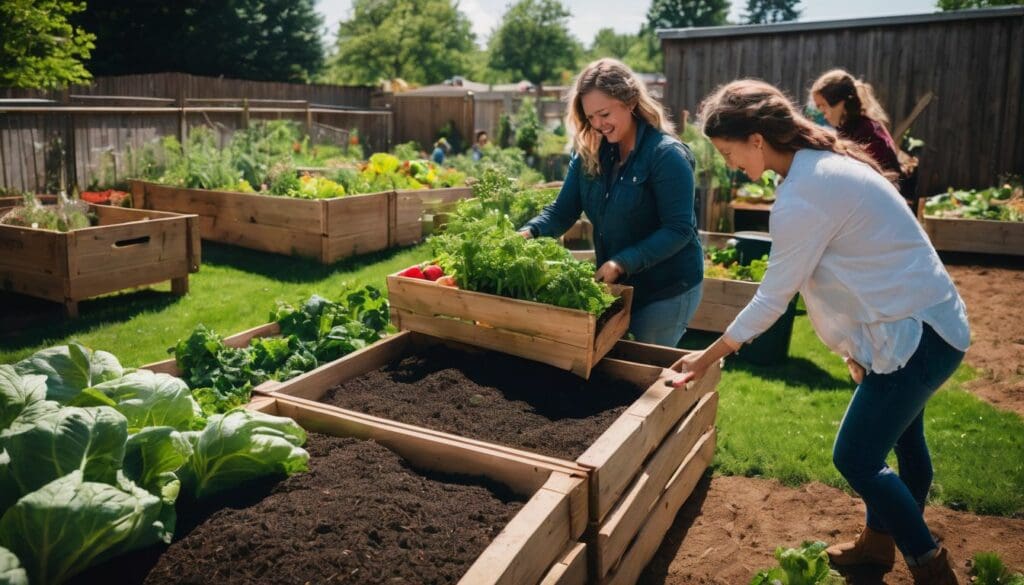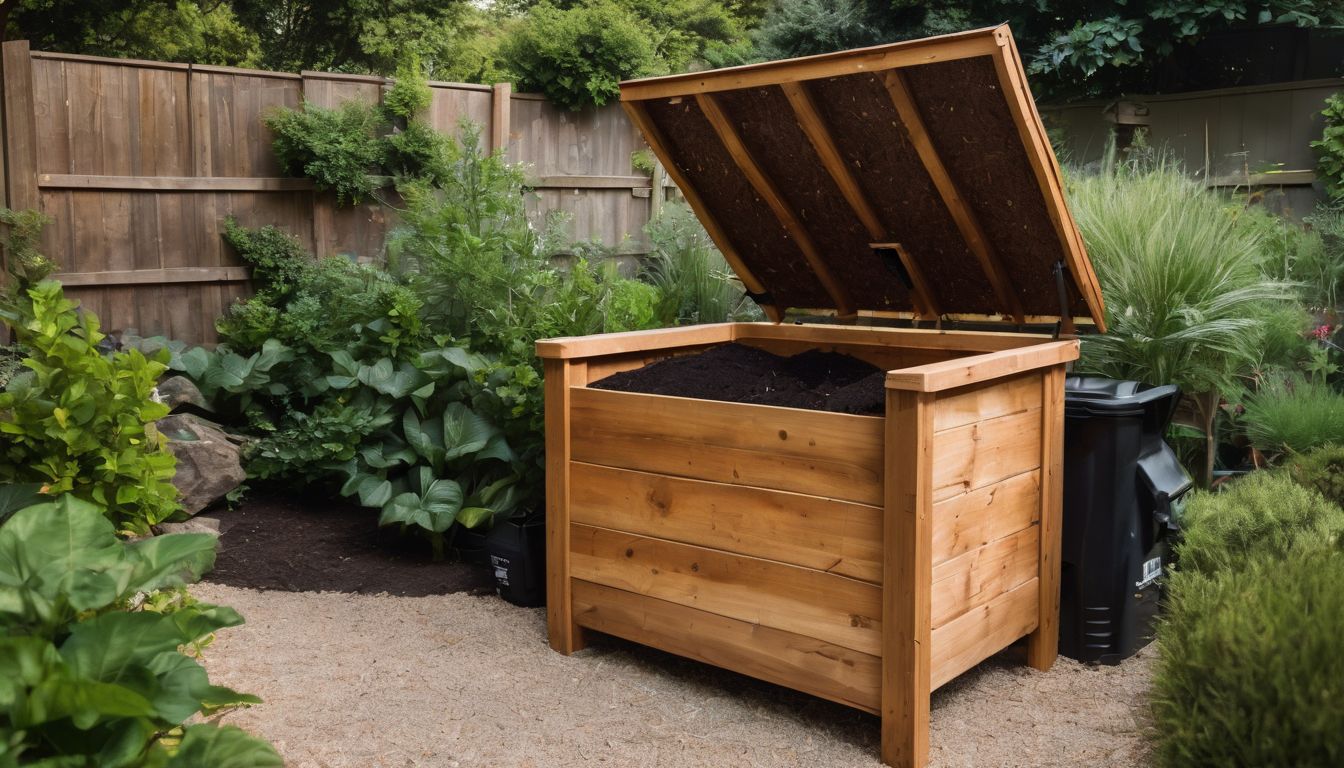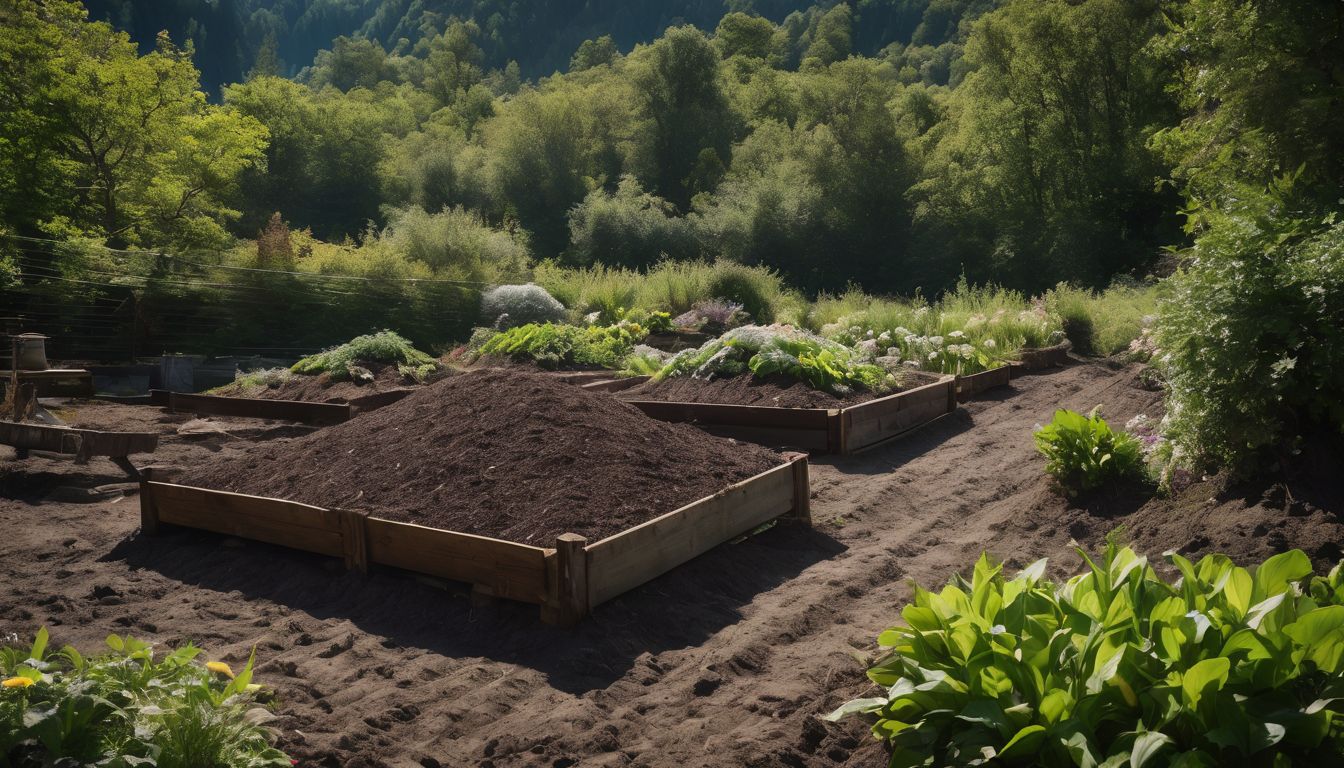Are you wondering how to reduce waste and help your local environment? Every year, tonnes of organic waste end up in landfills when they could enrich our gardens. This blog will guide you through the wonders of composting within community gardens, offering practical tips for a greener tomorrow.
Dive in and let’s turn scraps into treasures!
Key Takeaways
- Composting transforms kitchen and garden waste into valuable fertiliser, enhancing soil health and plant growth in community gardens.
- Implementing compost systems like backyard composting, vermicomposting, or community – scale composting reduces landfill waste and helps cut down greenhouse gas emissions.
- Community gardens with composting initiatives strengthen local communities by improving environmental sustainability, creating job opportunities, and fostering social connections.
- Educating members about the benefits of composting improves participation rates and ensures that everyone can contribute to a thriving community garden.
- Using compost decreases the need for chemical fertilisers in community gardens, leading to healthier produce and increased crop yields which benefit the whole community.
Why Community Gardens Need Composting
Composting is crucial for community gardens as it benefits the garden in multiple ways. From improving soil quality to reducing the need for chemical fertilisers, composting plays a vital role in sustainable gardening and environmental stewardship.
Local environmental, social, and economic benefits are also seen with composting in community gardens.
Benefits of composting for the garden
Composting turns kitchen and garden waste into a nutrient-packed material that benefits community gardens immensely. It’s a key practice in sustainable gardening, enhancing soil health and plant growth.
- Creates rich organic fertiliser: Composting breaks down food scraps and yard trimmings into dark, crumbly matter. This organic fertiliser feeds the local soil with essential nutrients, promoting robust plant development.
- Enhances soil structure: Adding compost to the garden helps improve soil aeration and water retention. Looser soil allows roots to spread easily and access oxygen they need for healthy growth.
- Encourages beneficial organisms: Earthworms and other helpful creatures thrive in compost-enriched soils. Their activity further aerates the ground and contributes to soil enrichment.
- Reduces disease risk: Healthy plants are less likely to succumb to diseases. Compost introduces good bacteria which can outcompete harmful pathogens in the soil.
- Limits chemical use: By using compost, gardens can cut down on synthetic fertilisers. This reduces exposure to potentially harmful chemicals.
- Lowers carbon footprint: Processing organic waste locally through composting means less rubbish transported to landfills. This step lowers greenhouse gas emissions associated with waste disposal.
- Provides year-round employment: Urban farms that adopt composting create jobs related to collection, maintenance, and fertiliser production from organic waste.
- Conserves water: Soil enhanced with compost retains moisture better than untreated soils. Gardens thus require less watering, conserving this vital resource.
Local environmental benefits
Composting provides local environmental benefits by reducing methane emissions from landfills, minimising the need for chemical fertilisers in community gardens, and enriching urban soils.
By diverting food waste from landfills through composting, the greenhouse gas emissions are significantly reduced, contributing to a more sustainable environment. Organic materials turned into nutrient-rich soil amendments enhance local soil health and promote greener living in urban areas.
Moreover, the practice of composting within community gardens encourages more responsible waste management and supports local green initiatives.
Local social benefits
Community gardens that incorporate composting offer a unique opportunity to bring the community together. Through shared efforts in managing compost heaps, educating fellow gardeners, and collaborating to reduce food waste, local residents can foster a sense of unity and cooperation.
This involvement not only strengthens social bonds but also promotes a collective commitment to sustainable living, reinforcing the values of environmental consciousness and green living within the community.
Community gardens embracing composting initiatives also contribute to year-round employment opportunities. By creating urban composting projects, local residents have access to meaningful work that supports environmental conservation while reducing food waste.
Local economic benefits
Switching from local social benefits to local economic benefits, community gardens that incorporate composting can experience significant financial advantages. The process of composting allows for the reduction of food waste disposal costs and the production of nutrient-rich soil amendments, saving money on purchasing traditional fertilisers.
Additionally, community-scale composting initiatives can create year-round employment opportunities within the local area and support small businesses that provide composting services or equipment.
The integration of composting into community gardens not only fosters environmental sustainability but also results in tangible economic benefits for both gardeners and the local economy.
Types of Composting Systems for Community Gardens
Backyard composting, vermicomposting, and community-scale composting are effective ways to create nutrient-rich soil for community gardens. Read on to discover the best practices for successful community composting.
Backyard composting
Backyard composting involves collecting kitchen scraps, yard waste, and other biodegradable materials in a designated area of the garden. Creating layers of green and brown organic matter encourages decomposition by beneficial microorganisms.
Regularly turning the compost pile helps aerate it and speed up the breakdown process.
Household composting offers an environmentally friendly way to reduce food waste while enriching local soils for community gardens. By diverting organic waste from landfills, this method contributes to food waste reduction and promotes year-round employment opportunities within the local community.
Vermicomposting
Vermicomposting uses worms to break down organic waste into nutrient-rich compost. It’s an ideal solution for community gardens as it can be done in small spaces and doesn’t produce odours.
By using red wriggler worms, kitchen scraps and garden waste are turned into valuable fertiliser, reducing the need for chemical fertilisers and creating a sustainable cycle of nutrients for plants.
Vermicomposting also provides year-round employment opportunities for local residents through sales of worm castings and worms themselves.
This method fosters community involvement by educating members about environmental conservation while simultaneously addressing the local economic benefits associated with vermicomposting.
Community-scale composting
Community-scale composting offers a sustainable solution for managing organic waste in local communities. It involves the collective effort of community members to process green and food waste into nutrient-rich compost on a larger scale.
This method not only reduces the amount of waste going to landfills but also provides valuable compost for community gardens, promoting local sustainability and reducing the environmental impact of waste disposal.
By implementing community-scale composting, environmentally conscious individuals can contribute to creating year-round employment opportunities within their communities while supporting conservation efforts.
Best Practices for Community Composting
When it comes to community composting, choosing the right location is key. Proper management of the compost heap and educating gardeners on best practices are also essential for successful composting in a communal setting.
Choosing the right location
Position the compost heap in an area that receives adequate sunlight, preferably on level ground. Ensure it is easily accessible to the whole community but away from any water sources or drainage systems.
The ideal location will have good airflow and be near a water source for easy maintenance without causing disturbances to nearby residents.
Consider potential odour issues and place the compost pile at a distance from buildings or areas where people gather. Additionally, choose an area where there’s enough space to expand the composting system if needed.
Managing the compost heap
After choosing the right location for your compost heap, managing it is crucial. Regularly turning and aerating the compost helps speed up decomposition. Balancing green and brown materials maintains a healthy mix for efficient breakdown.
Monitoring moisture levels ensures that the heap stays damp but not waterlogged to support microbial activity.
Regularly checking the temperature of the compost pile signals whether it’s breaking down properly or needs adjustment. Add more nitrogen-rich materials if it’s too cool or carbon-rich ones if it’s too hot.
Covering the pile retains heat and moisture, creating an ideal environment for decomposition while keeping pests away.
Educating gardeners
After effectively managing the compost heap, educating gardeners about the benefits of composting and its impact on community gardens is essential. Gardeners should be informed about the process of composting and how it improves soil quality, reduces the need for chemical fertilisers, and ultimately increases crop yield.
Providing workshops or informational materials can help raise awareness about proper composting techniques, which will lead to a more successful community gardening experience.
Gardeners need to understand the significance of using composted materials in their gardens and its positive effects on local environmental sustainability. By ensuring that all gardeners are well-informed about the value of composting, community gardens can contribute significantly to household waste reduction and year-round employment opportunities within their neighborhoods.
How Composted Materials Benefit Community Gardens
Composted materials benefit community gardens by improving soil quality and reducing the need for chemical fertilisers. This ultimately leads to increased crop yield and a healthier, more sustainable garden environment.
Improved soil quality
Soil quality is greatly enhanced by incorporating compost into community garden plots. Composted materials enrich the soil with essential nutrients, such as nitrogen and carbon, which are crucial for plant growth.
This leads to healthier plants that are more resistant to diseases and pests. Furthermore, the organic matter in compost improves soil structure, making it better at retaining moisture and nutrients for sustained plant growth throughout the year.
With improved soil quality, community gardens can produce higher yields of fruits and vegetables, promoting sustainable local food production.
Reduced need for chemical fertilisers
With improved soil quality from composted materials, community gardens experience a reduced need for chemical fertilisers. Nutrient-rich soil naturally supports plant growth without relying on synthetic additives.
This not only benefits the environment by reducing chemical runoff but also promotes healthier produce while lowering costs for gardeners.
By incorporating composted materials into the soil, community gardens foster a sustainable and self-sufficient approach to cultivation. The organic matter in compost enriches the soil, providing essential nutrients that support plant growth and productivity without resorting to harmful chemicals.
Increased crop yield
Composted materials contribute to an increased crop yield in community gardens. The nutrient-rich soil resulting from composting provides essential nourishment for plants, leading to healthier and more abundant harvests.
This enhanced fertility allows for the sustainable growth of a wider variety of crops, helping to support year-round employment opportunities within the community while reducing the need for expensive fertilisers.
Moreover, as composting enriches the soil with organic matter, it improves its water retention capacity and promotes better root development. Consequently, the overall health and resilience of garden plants are enhanced, maximising their ability to produce higher yields throughout each growing season.
Conclusion
In conclusion, composting plays a vital role in supporting community gardens. Gardeners can benefit from improved soil quality, reduced reliance on chemical fertilisers, and increased crop yield through the use of composted materials.
Community-scale composting systems provide an opportunity for year-round employment and support local environmental, social, and economic benefits. By adopting best practices for managing compost heaps and educating gardeners, community gardens can create a sustainable cycle that contributes to a healthier environment while fostering increased participation in local conservation efforts.
FAQs
1. What are composting and community gardens?
Composting in community gardens is a natural process where we turn waste like food scraps and leaves into rich soil to help plants grow.
2. Can anyone start composting in a community garden?
Yes, most people can join their local community garden and learn how to turn everyday waste into valuable compost for the plants.
3. Do community gardens only grow food during the summer?
Community gardens often plant different types of crops that can provide fresh produce throughout the year, not just in summer.
4. Are there jobs available at community gardens all year round?
In many areas, community gardens offer year-round employment opportunities, especially when they include tasks like maintenance or running educational programs.





